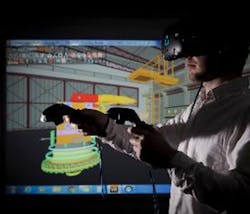Report highlights growing take-up of VR in offshore market
Offshore staff
LONDON – Oil and gas companies and service providers are increasingly adopting virtual reality (VR) technology, according to data analytics specialist GlobalData.
Its report Virtual Reality in Oil & Gas - Thematic Research examines the use of VR for subsurface studies, training and simulation, and for developing and improvising processes and products.
BP, in collaboration with Maersk Training, is applying VR to prepare its offshore drilling teams for real-life challenges, using simulation facilities in Svendborg, Denmark, and Houston to replicate physical conditions during drilling operations.
ConocoPhillips’ Norway division has created an Onshore Drilling Centre to operate North Sea drilling activities. The facility, which features a 3D visualization suite to form a virtual team of domain experts, evaluates real-time data, also providing 3D visualization of downhole drilling equipment.
Oslo-based Hydro and the Bergen-based Christian Michelsen Research institute have jointly designed a 3D simulator using VR technology known as ‘Cave’ to support oil and gas operations. Equinor is using the technology to create a 3D simulation of its offshore assets and operations.
Geophysicists, geologists and drilling engineers wearing 3D spectacles can study geologic structures in close detail and observe the various layers of oil, gas, and water present in the reserves.
At its research center in Qatar, ExxonMobil developed a 3D immersive training platform with EON Reality which creates a virtual plant environment to provide knowledge about equipment and processes to plant operators and engineers.
The simulated facility replicates various real-life scenarios such as an unplanned shutdown, abnormal operation, and emergency response in a safe, controlled environment.
Shell is deploying VR with 3D simulation for deepwater safety training for personnel at the Malikai project offshore Malaysia. This is designed to help technicians deal with potential hazards due to unsafe actions and to take appropriate measures to overcome any unforeseen event.
Saudi Aramco is using VR to train its personnel in how to operate critical equipment in oil and gas complexes correctly. In collaboration with Eon Reality, the company has built a practical training platform that demonstrates different processes to be adopted in real-life situations at an oil and gas facility.
Baker Hughes uses VR technology to assist digital design of oilfield equipment. This is said to lead to improved accuracy and clarity about the equipment and working mechanism prior to installation.
Halliburton is applying Microsoft technologies for simulation and 3D modeling of oil and gas reserves and to create designs for digital representation of physical assets.
01/02/2020
